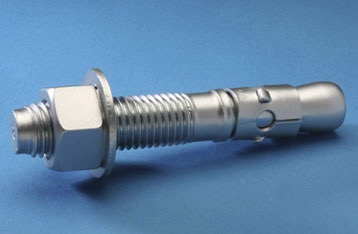Protecting Concrete Anchors

June 11
19:03
2020
The following is a press release provided to GlobalFastenerNews.com. Contact the individual company for additional information.
 Damaging the threads on a concrete anchor during installation is a common cause of escalating costs and diminishing longevity of applications. Care must be taken not to damage the threads during installation. Awareness of several basic practices will result in protecting the wedge anchor threads, which will increase cost effectiveness on the job site. Protecting the threads on anchors by correct installation techniques will save both time and money.
Damaging the threads on a concrete anchor during installation is a common cause of escalating costs and diminishing longevity of applications. Care must be taken not to damage the threads during installation. Awareness of several basic practices will result in protecting the wedge anchor threads, which will increase cost effectiveness on the job site. Protecting the threads on anchors by correct installation techniques will save both time and money.TIPS to Protect Wedge Anchor Threads:
All threads on wedge anchors are national coarse threads for each diameter. Once a wedge anchor is installed, its threaded end will jut above the surface of the concrete. Protecting this protruded area of the wedge anchor is crucial. If an installation tool, such as a hammer, damages the threads then the nut can no longer be put on or taken off.
· When installing a wedge anchor, the nut must be threaded on the threaded end of the wedge anchor so that the top of the nut is even with the top of the wedge anchor body.
· By taking the time to thread the nut on correctly, the threads will be protected during installation and allow the nut to be removed and threaded back on.
· Many wedge anchors are manufactured with a bullnose that extends above the threads to provide a surface for the hammer to strike without damaging the threads. Although the bullnose feature works very well, it is advised to thread the nut onto the wedge anchor as a precaution to ensure that the threads are not damaged by the hammer strike.
· The larger diameters of wedge anchor will need to be installed with extra caution in order to protect them from the hammers that will be need to be heavier.
TIPS to Protect Strike Anchor Threads:
Strike anchors are designed to be used in solid concrete base material and are best suited for medium to heavy duty fastening purposes. Drill a hole using a hammer drill and properly sized carbide tipped bit with a hole size that is equal to anchor size. It is important to drill a hole of sufficient depth. The anchor is set with no need to torque the nut.
· When installing a strike anchor, install the end nut before using the installation tool.
· Driving the strike anchor into the concrete with the nut already on the end will protect the end.
TIPS to Protect Drop-in Anchor Threads:
Drop-in anchors should only be used in solid concrete. The common uses for this anchor is for applications that require a flush mounted anchor and for applications when a bolt must be inserted and removed.
· First, drop the anchor in the hole with the threaded open end up towards the surface, then insert proper setting tool and hit with a hammer until the drop-in anchor is fully set.
· Remember that minimum embedment for each drop-in anchor diameter equals the length of the anchor.
Purchase all diameters, lengths and steel types of anchors direct from the manufacturer at www.confast.com


There are no comments at the moment, do you want to add one?
Write a comment